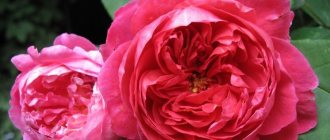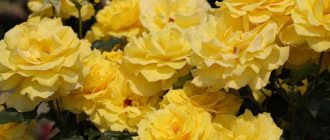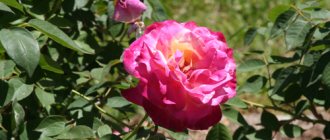Examples of rose varieties from the Climber group
The climbers include the popular lilac rose Indigoletta, famous not only for its unusual color, but also for its surprisingly strong aroma.
This group also includes the famous “rose of the world” New Dawn, which feels quite confident even in zone IV of frost resistance. The popularity of climbers forces breeders to annually develop new varieties of these roses. It is almost impossible to single out the best among them - it all depends on the individual tastes of the grower and the conditions on the site
We can only recommend paying attention to some promising varieties:
Monitoring reviews from rose growers allows us to highlight the strengths and weaknesses of different varieties of climbers:
“Alibaba’s growth energy is very powerful! Flowering is abundant, the bush independently clears itself of faded flowers. The aroma is strong. My bush is 2 years old and has never been sick. Now it is already 150-160 cm in height, about 1 m in diameter. I have not started shaping yet. Survived the winter well; in the spring I cut off only the tops of the longest shoots by 10-15 cm” (Olga, Moscow).
“Patty Lane was great for hot climates. It sits in the hellish sun all day, and the flowers practically do not fade, only brighten a little. In cool weather, the shade is pinkish-creamy in the center and milky around the edges. The flowers do not become smaller by autumn. Very delicate fruity aroma. The break in flowering is minimal. The bush itself is very healthy, has not suffered from anything. The thrips did a little damage, but without much damage, and the spider mites were spared even in the heat. I try to feed well, so I don’t see any problems with growth. But the vines are very prickly and tough, so you need to keep them in a climbing form until the shoots are ripe. Then all that remains is to cut – you won’t bend it” (Natalia, Crimea).
“Don Juan is handsome! Large, magnificent flowers that do not respond to rain at all. True, in the second season after planting I had to tinker and treat the rust and tear off the leaves. But the bush recovered well, and even continued to bloom, despite the fungus. It always winters well. Yes, styling is not easy, you have to work hard, but this rose is worth it!” (Galina, Moscow region)
“Dukat (aka Lancelot) never ceases to amaze! It blooms first of all roses - at the end of May, blooms in two abundant waves, and in between - in single large clusters in different parts of the bush. This results in almost continuous flowering. The color of the flower is very optimistic, bright, on some flowers I notice a slight pinkish blush. The flowers do not suffer from rain and do not fade in the sun. The bush does not suffer from anything, it winters well under minimal spunbond cover, although the manufacturer declared zone VI, and I have a plot in the Moscow region” (Olga, Zhukovsky).
From the comments of rose growers, you can see that growing climbers is possible in most of central Russia. They feel especially good in the southern regions. The most important thing is to carefully choose varieties.
Remontant climbing roses resistant to diseases affecting leaves
Among the many varieties, there are several that are easier to care for, and in response, the bushes grow large and bloom luxuriantly. And although climbing roses are classified as a separate group, among them there are remontant varieties that are relatively resistant to diseases:
- Ducat - yellow flowers up to 10 cm in diameter. The height can even reach 3 meters.
- Hella - white flowers, with an open center, 8 cm in diameter. The height of the bush itself is up to 2.5 meters.
- Rose de tolbiac – very double flowers of rich pink color. Petals are wavy, 8 cm in diameter. Height 2 meters.
- Guirlande d'amoure - you can't immediately recognize a rose in this bush. It is strewn with many small white roses, with an open middle.
- Rozengarten Zweibrucken - amazes with fragrant carmine flowers, about 10 cm in diameter. The bush grows up to 2.5 meters.
Despite the fact that remontant roses are in many ways inferior in comparison with modern species, they have many fans. In addition to the quality of the flowers, this can be explained by their long history. After all, just imagine that a rose can grow in your garden, which the kings of France admired 200 years ago. After all, history always gives the garden its own zest and mystery.
Whether or not to take up growing a remontant rose is up to you to decide. But, like any flowers, in response to care they will reward you with magnificent inflorescences that delight the eye and soul.
Antique roses, remontant hybrids:
Differences from other roses
Climbing rose “jasmine”: description of the variety, photos and reviews
All modern roses were bred by crossing old roses. Therefore, in modern roses you can always find features of their ancestors. And in old garden roses one can recognize the characteristics of wild-growing species of roses. After all, they also turned out as a result of arbitrary crossing of wild roses. Unlike ancient roses, modern groups are characterized by greater frost resistance and less susceptibility to disease.
They also differ in the duration of flowering. As a rule, old roses bloom once. True, old tea, Bourbon, and remontant roses bloom again, but the second flowering is significantly inferior in abundance to the first. Modern ones go through several waves of flowering. Some types of hybrid tea roses can bloom until late autumn, even before snow falls.
Ancient roses are inferior to modern roses in the variety of colors. The petals of old roses are beautiful, but are usually painted in soothing pastel colors. The colors of modern roses vary widely - from almost black to white, from single-color to two-color and variegated.
Caring for old roses is more difficult. Almost all varieties of old roses have many prickly thorns, large bushes, and long lashes. In addition, they are afraid of frost. All this requires physical effort and regular, careful care: timely pruning, prevention, construction of winter shelters.
Group of roses “Climber”: distinctive features
Climber roses do not grow higher than 3-4 meters, so they are often used to decorate low fences.
Climbers are plants obtained by crossing different types of roses and having the following characteristics:
- powerful, well-branched bush;
- long, fairly thick and tough shoots.
Sometimes a characteristic feature of climbers is called large-flowered or a tendency to re-bloom, but within this group there are varieties that do not have these properties.
The shoots of climbers differ from the shoots of “real” climbing roses - ramblers - in that they are weakly pliable and less flexible. They do not belong to the creeping type, but to the drooping type. Up to a certain length, the lashes of climbers grow as if they are erect and only then begin to bend under their own weight.
The rigidity of the shoots dictates certain restrictions when growing this variety of roses. They are quite difficult to cover for the winter, so rose growers need to choose climber varieties, paying attention to the recommended USDA frost hardiness zone.
Tip #1. Climber seedlings are marked on the packaging with the abbreviation LFC (Large-Flowered Climber). This icon will help distinguish them from ramblers, which are marked R (Rambler).
Varieties
Climbing rose kimono (kimono): description and photo, reviews
Let's look at the most popular varieties of remontant roses.
- Georg Arends. The bud looks like a pointed cone. The flower is large, pink in color with a satin sheen and a tart aroma. The plant blooms at the end of May, the next flowering occurs in mid-summer.
- George Dickson. Double flowers are painted in rich crimson colors with a transition to red. The bush is quite tall and belongs to the group of essential oil plants. Flowers are used in the perfume and cosmetics industry.
- E. G. Werkmeyster. The flowers, like most remontant varieties, are large and double. Painted in bright yellow warm colors. The foliage is dark green with a shiny surface. Secondary flowering is weak, primary flowering occurs at the beginning of the summer season.
- Paul Neuron. The flowers resemble a bowl in appearance, large, double, deep red, located at the end of long, slightly drooping shoots. The aroma is persistent. The plant can reach 200 cm in height. Subsequent flowering occurs in the summer months.
- Prinz Max zu Schaumburg. The flowers are painted in soft salmon and coral tones. The aroma is rich and persistent. Flowering period is spring and summer.
- Ulrich Brunner Films. Cup-shaped flowers in red-carmine tones, with a persistent aroma. Flowering occurs in spring and continues in summer, but not so abundantly.
- Frau Karl Druschki. The flowers are cup-shaped, white in color, some petals are colored pinkish. It belongs to plants that can bloom until autumn, retaining buds and blooming flowers until the onset of cold weather.
- Hugh Dickson. A bush with the largest crimson flowers, turning into scarlet. Flowering occurs at the beginning of the summer season, with secondary flowering occurring in July.
- "Ferdinand Pichard". The plant is distinguished by the unique colors of its buds. The petals are painted in shades of crimson with vertical light stripes or spots. Each stem forms up to 5 ovaries. The aroma is strong. The bush is most resistant to various diseases, but not resistant to precipitation. The maximum height of the plant reaches 200 cm.
- Baron Girod de L'Ain. The flowers are double, purple, red with a light edging. The aroma is persistent and fragrant. From 3 to 5 flower buds are formed on the shoots. "Baron Giraud de l'Hain" reaches 150 cm in height and has average resistance to rainfall and disease.
Bush care
Pruning of remontant roses is carried out in two types: medium, long. It is recommended to keep 8-12 buds on each last year’s stem, and 4-6 on new ones. During the summer season, fertilizers based on humus and peat are regularly applied to prevent the possibility of soil drying out and stimulate the development of buds, root systems and shoots.
Mineral and organic fertilizers (nitrogen, liquid mullein, phosphorus, potassium) are applied according to the following scheme:
- the first feeding is done during the growth of the rose;
- the second - during the period of bud formation;
- third - after flowering;
- the latter - during the period of lignification of shoots.
A repair rose requires shelter for the winter; for this, the bush should be properly prepared. All flowers, buds, leaves and immature shoots are removed, and additional treatment with pesticides is carried out. It is not recommended to prune roses in the autumn season, as this can weaken the plant and can lead to the death of the flower in winter. Plants with mature and lignified trunks endure wintering more easily than weak and diseased plants. The success of wintering is influenced by the feeding system used.
For information on remontant hybrids of ancient roses, see the following video.
Care
Climbing rose climbing iceberg: planting and care
Proper care is very important for the development of the plant. Providing favorable conditions is the key to full growth. By following some simple care rules, you can achieve success even in growing the most capricious varieties of roses.
Watering
In the first two years after planting, it is necessary to provide the plant with regular and abundant watering. Older bushes require more sparse, but plentiful.
Timely watering is very important
Water for irrigation must be settled and not cold. Using water from a hose is detrimental to the root system of roses.
Over-watering should be avoided. It can cause root rot. It is better to water plants older than 2 years only when the soil dries out.
Feeding
For remontant varieties of roses, regular feeding is very important. For this purpose, mineral and organic fertilizers are used.
Roses are responsive to foliar feeding
Nutrition occurs due to mineral supplements, and organic matter, decomposing, helps their absorption.
Basic feeding is carried out in three stages.
In the spring, after removing the cover, complex mineral fertilizer is applied. It will promote the formation of shoots and the formation of buds. In summer, during the period of active flowering, you can apply both mineral fertilizers and organic matter. Under no circumstances should fresh manure be introduced. When using organics, you must strictly observe the proportions when preparing the solution. After flowering, apply mineral fertilizers
You should pay attention that they do not contain nitrogen. It can provoke unwanted growth of shoots before sheltering for the winter.
For your information! Foliar feeding is effective. With this application of fertilizers, nutrients quickly flow directly to the plant. They are carried out before budding and after pruning, as well as under particularly unfavorable weather conditions.
Pruning and replanting
Pruning for climbing roses is the key to successful growth and flowering. It is carried out in three stages - spring, summer and autumn.
Pruning is an important part of care
- Spring. Its purpose is to remove shoots damaged after wintering. Those that are necessary for proper formation are also removed. It is needed to force the shoots to curl in a given direction.
- Summer involves removing faded inflorescences.
- Autumn pruning involves removing dried and diseased shoots. For climbing roses, only the shoots of the current year and some of the two-year-old ones are left. Before sheltering for the winter, the length of the shoots is shortened by half the length.
Important! Pruning should be done with a well-sharpened garden tool. It must be disinfected before the procedure.
Transfer
Under certain conditions, it may be necessary to transplant to another place. For young plants this will not be a problem, but replanting older ones will be very problematic.
Before transplanting, the shoots are removed from the support and shortened by 2/3 of their length. Next, the root system with a large lump of earth is removed.
The transplantation procedure is identical to that used when planting young seedlings. The timing of these two manipulations also coincides.
Wintering
The climbing rose Ali Baba is not particularly frost-resistant and requires shelter for the winter. If this is neglected, the plant may not only suffer, but also die.
Before laying under cover, the shoots are shortened. It is recommended to treat the lashes with Bordeaux mixture to prevent the development of fungus under cover. After this, the lashes are removed from the support and pinned to the ground.
Important! The shoots should be laid on a previously prepared area. A layer of sand is poured onto the installation site and spruce branches are laid out.
For shelter it is better to use an air-dry method. It consists of installing a frame and then attaching covering material to it. This method will ensure free air circulation during the plant's dormant period.
Growing and care
Rose Eden Rose - description and characteristics of the variety
The description of the variety states that the shoots of the rose grow up to 200 - 250 cm. The declared width of the bush is up to 120 cm. It should be noted that in the southern regions the rose is capable of climbing to a length of more than 3 m, and requires shading during the midday hours. Otherwise, the flowers will fade in the sun and quickly fly away.
Landing rules
The rose is planted taking into account the dimensions of an adult plant, in a well-lit area, protected from wind and drafts. Low areas should be avoided so that the planting site is protected from excess moisture during rain or when snow melts. Groundwater located close to the surface will also prevent the rose from fully developing. A waterlogged root system can lead to the death of the plant.
The depth of the planting hole is approximately 70 - 80 cm, with a diameter of up to half a meter. It must be filled with a nutrient mixture to ensure comfortable development and rapid rooting for the young plant. For areas with loamy soil, mix in equal parts:
- peat;
- sand;
- turf land;
- vegetable compost.
Planting scheme
Additionally, it is recommended to fill the pit with 200 g:
- ash;
- phosphate fertilizer;
- bone or dolomite meal.
If the soil in the area is poor and sandy, the hole should be made deeper and clay should be used instead of sand. Then the moisture and nutrients needed by roses will be retained at the roots longer.
Before planting, shoots and branches are shortened to 30–35 cm so that the rose spends energy on rooting and does not feed many buds. The roots should also be refreshed. To do this, use sharp pruning shears to shorten each root by 2–3 cm. The cut reveals white tissues; dry roots have wood-colored tissues; they are trimmed to a living, white one. Seedlings purchased with an open root system are first left in a container with water up to the level of the root collar for a period of 1 hour to 1 day. A good sign is the presence of small white water-sucking roots on the roots of the plant.
Important! When planting a climbing rose, the root collar should be buried 10–13 cm underground. After planting, the soil around the bush is compacted and watered abundantly.
Watering
In the first weeks, it is necessary to monitor the soil moisture at the roots of the young bush. After watering, the drying soil is loosened to avoid cracks when drying. An adult plant needs regular watering during dry periods. It is enough to moisten the soil around the rose well once every 7 to 10 days. This requires 10 - 12 liters of water, and to prevent the liquid from spreading over the surface, you can make a small groove around the bush and water it gradually. You can prevent moisture evaporation by mulching the root area. For this purpose, cut grass that has dried in the sun is suitable.
Fertilizer
In the first year after planting in a properly filled hole, the rose does not need additional feeding. Enhanced nutrition is necessary for a plant that blooms fully all summer. The rose fertilization system is based on three necessary elements:
- nitrogen: the plant’s need at the beginning of the growing season, when the plant grows green mass (shoots, foliage);
- phosphorus: a plant that has received the required amount of the mineral actively develops the root system and produces buds;
- potassium: stimulates growth and flowering, works as an immunostimulant for roses.
It is recommended to feed the rose with organic fertilizers (nitrogenous) until mid-summer. Complex fertilizers containing, in addition to potassium and phosphorus, iron, magnesium, sulfur and other necessary elements can be used until autumn.
Important! Iron deficiency in roses is manifested by chlorosis, when the foliage tissue between the veins becomes lighter.
Feedings can be:
- root: when fertilizer is scattered into the root area or the rose is watered with their solution;
- foliar (on the leaf): in this case, the fertilizer solution is made weaker so as not to cause burns to the leaves and the above-ground part of the rose is sprayed, wetting the leaf as much as possible.
Fertilize roses early in the morning or in the evening after sunset. It is advisable to carry out foliar feeding in cloudy, windless weather.
Feeding the bush
Trimming
There are two main types of pruning: sanitary and shaping. Sanitary pruning is carried out in the spring before the start of the growing season. All dry leaves with signs of damping off or infectious burns are removed from the rose. The shoots are shortened to healthy wood.
Formative pruning is used to increase decorativeness, as well as to stimulate branching of shoots. Remove weak lateral branches and branches growing inside the bush. In an adult bush that has been growing for more than 5 years, old woody shoots should be cut out; they bloom less and are difficult to fit under cover.
Sanitary pruning
Disease Prevention
Rose Ali Baba has good immunity against fungal diseases. In order to avoid giving infections a chance, it is important to fertilize regularly and prevent the bush from becoming too thick. High humidity levels can also cause fungus to spread.
Pest Control
Young rose buds and leaves attract pests:
- the aphid feeds on the sap at the base of the bud;
- rose leaf roller, a small green caterpillar, nibbles leaves;
- The roseate sawfly penetrates the upper part of the shoot, where it feeds on succulent tissues; the pest can be identified by the bowing tops of the shoots.
You can get rid of voracious insects by spraying the rose with an insecticide; some preparations require repeated treatment.
Rose Ali Baba in a flowerbed
The climbing rose Ali Baba is suitable for growing on arches, supports and pergolas; it can be used to drape an unpresentable corner or wall. Blue and white sages and tall bluebells look charming as companions.
Description of rose Ali Baba
Grown in England by C. Warner, one of the country's leading rose growers, this stunning variety features large orange-pink flowers with a captivating fruity scent.
How the Ali Baba rose blooms
The variety belongs to climbing roses with repeated flowering. The height of the shoots can reach 3 m. Large flowers are collected in inflorescences of 5 to 10 pieces. on each.
For your information! It has won many awards for its fantastic blooms and ability to grow to large sizes. The flowers have a truly unique color with shades of salmon and peach. Their aroma is strong and fruity with notes of peach and passion fruit. The flowering is long-lasting, throughout the summer months this beauty pleases the eye.
Advantages and disadvantages
Like every variety, Alibaba rose has both pros and cons.
This variety has quite a lot of advantages
Each one is worth paying attention to when choosing it for the site.
Undoubtedly, the main advantage of this species is the flowers. Besides the fact that they look simply stunning, this beauty will bloom all summer long.
It is also worth noting that, despite the intolerance of many types of roses to an abundance of precipitation, this variety is very resistant to it. Even if rainy weather occurs during the flowering period, the plant does not lose its beauty.
High resistance to disease is another advantage of this variety. This rose is very rarely affected by powdery mildew and various spots.
For a climbing rose with an impressive length of shoots, their flexibility is an undeniable plus. Thanks to this quality, roses can be used to decorate various objects, regardless of the complexity of their shape. The risk of damaging the shoots is minimal.
This variety has fewer disadvantages than advantages. It is thanks to this that she became a favorite of rose growers and received so many awards.
One of the disadvantages is intolerance to direct sunlight. The plant should be illuminated only in the first half of the day; afternoon bright sunlight is harmful to it. In bright light throughout the day, the color of the flowers fades and they fall off faster. Leaf scorching is also possible.
Note! The requirement for soil composition is a dubious drawback, but it cannot be considered an advantage. Rose Alibaba prefers nutritious and light soil
Poor and heavy soils are absolutely unsuitable for its cultivation.
Use in landscape design
Thanks to its exquisite flower color, flexibility and impressive length of shoots, the Alibaba variety is often used by landscape designers.
Powerful vines covered with large salmon-colored inflorescences will decorate any landscape composition. Arches, gazebos, and walls of houses entwined with this climbing beauty will become the highlight of the site.
In combination with roses of lower growing varieties, you can create a continuously blooming bright composition. An additional advantage will be the aroma, the fragrance of which will not leave anyone indifferent.
For creating a flower garden in the English style, this variety is just a godsend. It is this rose that can become the main accent in such a composition.
Use Cases
Using the Ali Baba variety, you can successfully decorate anything: wooden fences, forged fences, building walls. Using various types of supports and resorting to the services of a climbing beauty with fragrant flowers in warm colors, it is easy to design a hedge, arch, or pergola. A garden gazebo covered with roses of this variety will turn out to be very romantic and even luxurious. If desired, low-growing flowering crops with buds in white, red, and pink shades are planted next to the decorative perennial Alibaba.
Ali Baba is a climbing rose that never ceases to amaze. Cascades of burning coral, pink, and orange buds are especially beautiful in the rays of the setting sun. And even when the last ray disappears over the horizon, the bright buds continue to glow. It is impossible not to notice, it is impressive with its majestic height of about 2 meters, a wonderful strong aroma and, of course, flowers.
Rose blossom
Inflorescences are formed on biennial and older shoots.
The most magnificent flowering is observed during the second wave, when lateral shoots appear on the basal shoots, which also bloom.
The rest period ranges from several days to several weeks, depending on the variety.
Rose Ballerina blooms very magnificently
Care during and after flowering
During the period of budding and flowering, the Ballerina rose, like other varieties, needs potassium. A mixture of 1 cup of wood ash per 1 bucket of water or 30 g of potassium sulfate per bucket of water is added to the soil.
For lush flowering you will also need a solution of 1 tbsp. spoons of calcium nitrate per 10 liters of water.
Important! At the beginning of summer, 80 g of superphosphate is applied under the bush
What to do if it doesn’t bloom, possible reasons
A rose does not bloom if there is a lack of sunlight, watering and fertilizing. Flowering can most often be achieved by changing the care conditions.
Bloom
Like every flower, the climbing rose has a period of activity and dormancy.
Rose Juliet
The period of active development of this rose variety occurs in mid-spring - mid-autumn. Its peak is summer. It is at this time that it is necessary to provide the plant with proper care.
Care during flowering and after
During the three summer months, the Alibaba rose actively blooms. During this period, she urgently needs feeding. The application of mineral and organic fertilizers at this time is mandatory.
Wilted inflorescences must be removed. This procedure stimulates the re-blooming process.
At the end of flowering, the plant should be fertilized with complex mineral fertilizer. But it should be remembered that the presence of nitrogen in its composition is undesirable.
If it doesn't bloom
There are times when it is not possible to wait for abundant flowering, or it is completely absent. There could be many reasons for this. All of them are associated with mistakes that were made during landing.
Note! Full flowering of roses of the Ali Baba variety occurs in the 3rd-4th year of growth. In the first years after planting, you don’t have to wait for it.
The reason for the lack of flowers may be an incorrect soil composition or an inappropriate place to place the rose. In this case, you should resort to transplanting the bush to another place.
Diseases and pests
The Alibaba rose variety is resistant to such common diseases as powdery mildew and various types of spotting. With proper care, the plant practically does not get sick. But if infection occurs, you should immediately treat it with special preparations.
The most common pests of roses are aphids, spider mites, caterpillars and thrips. To combat them, as well as for prevention, roses should be regularly sprayed with chemicals.
Note! Among the variety of climbing roses, the Alibaba variety undoubtedly deserves attention. Tall powerful shoots crowned with large fragrant salmon-colored inflorescences cannot leave anyone indifferent
Agricultural technology and reproduction do not require special skills and effort. If you follow all the rules of care, it is quite possible to grow a healthy and lushly flowering plant. This variety is widely used in landscape design. This is due to the high decorative qualities of the Alibaba rose variety. By planting this beauty in the garden, you can enjoy the beautiful flowers and their unique sweet aroma all summer long.
Application in landscape design
Rosa homage Barbara
Groups of old roses are readily used by landscape design specialists. They are used to construct hedges. With the help of such fences, you can zone a site or isolate yourself from neighbors. White Alba roses look beautiful. In the case of single-row planting, the bushes are planted at a distance of 70 cm from each other. In the case of a two-row, the distance between the roses is left the same (70 cm), and between the rows - 100 cm.
Climbing varieties of ancient roses are used for vertical gardening. They decorate arches, pergolas, gazebos, and obelisks. Columns or obelisks covered with roses will create a solemn atmosphere in the park area of your site.
Antique roses also look very beautiful in solitaire (single) plantings. Rose is a self-sufficient plant. It is beautiful in itself, so it can become the main focal point in your garden.
This is especially important when the area of your site is very limited. For single plantings, bush types of old roses are chosen. These roses are not suitable for mobile, container plantings
But they look good in combined flower beds - mixborders. As companion plants, choose those that have a color contrasting with the color of your rose.
These roses are not suitable for mobile, container plantings. But they look good in combined flower beds - mixborders. As companion plants, choose those that have a color contrasting with the color of your rose.
Description and advantages of the variety
Breeder Christopher H. Warner England, in 2007 presented the world with his masterpiece Alibaba.
The buds have a very interesting, complex color. From coral to pink-orange, from copper to honey. The buds are regular, goblet-shaped at the beginning of dissolution, large. In full bloom, these are densely double flowers, collected in bouquets. The aroma is fragrant with fruity notes of passion fruit and apricot. The rose is a remontant rose - it blooms almost continuously until frost.
High resistance to powdery mildew and spotting. The buds do not droop in the rain. Frost resistance is average, recommended growing zone is 6.
Flexible long shoots reach 200-250 cm. The size of the bush is 250 by 120 cm.
World recognition and awards
- "Gold Standard" tests of the UK National Institute of Agricultural Botany NIAB and the British Rose Breeders Association, 2007,
- first prize at the Lyon rose competition (France), 2008 for fragrance,
- "Best Climbing Rose" competition La Tacita (Italy), 2011,
- bronze certificate of the rose competition The Hague (Netherlands), 2014,
- bronze medal of the Gifu Rose Competition (Japan), 2014.
If you're looking for a climbing rose for your garden, Ali Baba is worth a look.
Very large double flowers
Strong fruity aroma
Disease resistance
Alibaba (Alibaba)
Characteristics of the variety:
Classification group climbing, climber
Flower description: The color changes from salmon in young flowers to pink in re-blooming. The average diameter is 10 -12 cm. There is a bright, rich aroma of passion fruit and apricot. The flowers are double, delicate, scalloped.
Flowering pattern: Medium inflorescences of 3-5 flowers. Flowering is abundant and continuous.
Habit: The bush is large, harmonious, spreading, prickly. Easy to install for winter. The shoots are flexible. Height from 200 to 250 cm, width from 100 cm to 110 cm. The foliage is bright, shiny, green.
Frost resistance: high
Disease resistance: high
Light requirement: partial shade
Special Notes: Self-cleaning grade
Reviews from experienced rose growers:
In the second year of flowering, it shot out a strong shoot about 1.5 m with twenty-nine buds. And this is right after the first flowering on the side shoots of overwintered branches! Wonderful aroma, delicate ruffled flower, self-cleaning and excellent health - a favorite! The rose blooms almost without interruption; when putting it away for the winter, I cut off the buds and flowers. (Olga Ivanova, St. Petersburg)
An ideal rose in all respects, it smells oh-so-delicate, doesn’t get sick, fits, doesn’t fade and cleans itself, on my bush there are always 20-30-40 flowers, so it’s not clear how long a flower lasts, in her case it doesn’t matter. Beautiful, and the bush is beautiful against the backdrop of bright foliage, I would buy a second and a third... (Natalia Evgenievna Petrova, Moscow)
Very full, corrugated flowers up to 12 cm, with a carved edge, in iridescence of complex colors: pink, apricot, ocher, copper in the depths of the flower
A beautiful bush that doesn’t fall or fall apart! The strongest aroma, very generous in flowering. Absolutely resistant to diseases and weather troubles: it can easily withstand rain, does not fade in the sun, and is self-cleaning. And in the first year the flowers fell off very quickly. (Kotenko Svetlana Aleksandrovna, Kharkov)
Very full, corrugated flowers up to 12 cm, with a carved edge, in complex colors: pink, apricot, ocher, copper in the depths of the flower. A beautiful bush that doesn’t fall or fall apart! The strongest aroma, very generous in flowering. Absolutely resistant to diseases and weather troubles: it can easily withstand rain, does not fade in the sun, and is self-cleaning. And in the first year the flowers fell off very quickly. (Kotenko Svetlana Aleksandrovna, Kharkov)
Characteristics of the variety
The Alibaba variety was officially registered in 2007 under the Alibaba rose brand (CHEwalibaba, Schloss Bad Homburg, Sunset Glow, Ali Baba). The selection work was highly appreciated by professionals:
- 2007 (Gold Standard Rose Trials) the variety was awarded the Gold Standard award at variety trials in England.
- 2008 Winner at an exhibition in Lyon (France) for fragrance.
- 2011 Championship in the Climbing Roses category at an exhibition-competition in Italy.
- 2014 bronze award-certificate of the competition in The Hague (Netherlands); bronze medal at the rose competition in Japan.
Alibaba rose climber
Roses from the British breeder Christopher Warner, the originator of this variety, are characterized by resistance to weather vagaries, original colors and high repairability.
Alibaba flowers under optimal conditions grow large (10 – 12 cm), not inferior in size to hybrid tea ones. The flower is semi-double, airy due to the wavy edge of the petals. The color is complex, changing throughout the life of the flower and becomes lighter. The illusion of glow is created thanks to the bright coloring at the base of the petals.
A plant with high growth energy, in the first year after planting it increases its green mass and at the same time produces bunches of buds. Flowering occurs mainly at the ends of shoots. An adult rose, for abundant flowering along the entire length of the shoot, must be placed on a support (horizontal).
Horizontal management of rose shoots
The advantages of the variety include:
- continuous flowering;
- strong pleasant aroma;
- well-leafed shoots, not bare at the bottom;
- resistance to rain: petals are not damaged by moisture and do not rot;
- self-cleaning: wilted flowers fall off and do not require pruning, do not mummify, reducing the decorative value of the bush;
- high plant resistance to the most common diseases in our latitudes (powdery mildew and black spot).
Don't expect cascades of fragrant clusters in the plant's first year in the garden. In the first 2–3 years after planting, the rose adapts to a new place and gains strength. Flowering may end quickly, and the expected aroma may not be heard.
Important! With good care, a rose is able to reveal its potential no earlier than 3–4 years of life in a permanent place
Reproduction
Rose James Galway
The most acceptable method of propagating climbing varietal roses is cuttings. The use of this method guarantees the production of seedlings that will be completely identical to the mother plant.
Propagation by seeds does not, in most cases, allow obtaining roses with the required varietal qualities. Obtaining new specimens by rooting cuttings is possible, but the result is quite a small amount of planting material.
The best time to start preparing planting material is in the fall. After shortening the vines before placing them under cover, many trimmed shoots remain. They can be used for subsequent preparation of cuttings.
The method of propagation by cuttings consists of several stages.
- Shoots pruned in autumn, after removing their leaves, are stored in damp peat or sand at a temperature of 1-2 °C until spring.
- In the spring, cuttings 10-15 cm long are cut from the shoots. The lower cut is made oblique under the bud, and the upper cut is straight above it. The lower part is treated with a solution of a growth stimulator.
- In April - May you can start planting in the soil. Depending on climatic conditions, it is produced either in a container or in open ground. Planting is carried out so that there is only one upper bud above the soil level.
- After planting, a film cover is installed to create a microclimate in the greenhouse.
- As the soil dries, watering is carried out.
Some cuttings will take root by mid-summer.
The cutting method allows you to obtain high-quality planting material, while all varietal characteristics are preserved.
What are remontant roses?
Their main characteristic is clear from their name. They all bloom repeatedly within one season. At one time, they became a real breakthrough in the world of rose growing, because previously not a single variety had re-bloomed. However, they are now significantly inferior to newer species such as hybrid teas and floribundas.
And the whole point is that, although remontant roses bloom twice during the summer, the second bloom is much more sparse than the first. More modern species and varieties do not have this drawback, and are able to bloom not only repeatedly, but even continuously throughout the season. At the same time, the quality of the flowers remains high.
The second disadvantage is their susceptibility to disease. They are not as resistant to fungi as later species and varieties.
A reasonable question arises: why are they still grown in gardens if they have so many shortcomings? The thing is that among remontant roses there are varieties whose flowers even today meet the highest standards in floriculture. The effort is worth it to see the beautiful flowers in all their glory, striking in their beauty. And although this spectacle will not last so long, lovers are ready to surround the renovated species with care in order to decorate their garden with them.
In general, caring for and planting remontant roses requires compliance with all the same rules as for other species. It’s just worth paying a little more attention to preventative treatments and regular inspections of the bushes.
They require mandatory pruning to ensure re-blooming more luxuriantly. It is also necessary to apply nitrogen fertilizers throughout the season to promote green growth and abundant flowering.
A large bush, it keeps the tree trunk circle in the shade, which allows watering to be done very rarely, only in the driest weather.
The height of the remontant rose bush reaches 1.5 meters. Of course, it cannot be called compact, which is often also considered as a disadvantage. However, in some gardens tall bushes are in great demand. They are completely self-sufficient and can decorate the site on their own. Not all gardeners like to create groups, and for them a large rose bush is a real find.
Speaking about wintering, it is necessary to note the poor resistance to frost. You need to carefully take care of the shelter in preparation for wintering.
Plant care
In open ground, caring for Abracadabra is similar to the standard for all tea hybrids.
Watering
Watering rules and humidity
The variety is resistant to drought, but you should not let the soil dry out. It is enough to wait until the top layer of soil dries 3 cm deep, and then water again.
Important! The best time for this is early morning. And in the evening of the same day it is worth loosening the soil and slightly hilling the bush
Fertilizing and soil quality
The first organic fertilizers are applied when the buds are still dormant. Compost or humus is mixed with the topsoil. Then, throughout the active growing season, potassium-phosphorus fertilizers are applied at intervals of 3 weeks.
Pruning and replanting
Formative and sanitary pruning is carried out in spring and autumn. In April, before the buds awaken, all broken and damaged branches that have frozen during the winter are cut off. In the fall, shortly before frost, the shoots are shortened, removing unripe tops and remaining buds.
The rose does not need to be replanted, but in the central zone, where in winter the temperature drops below −30 °C, it is practiced. The bush is dug up completely, the roots are lowered along with a lump of earth into a box with sand and placed in the basement, where the temperature is maintained at 4 ° C. In winter, the soil needs to be moistened periodically.
Features of wintering a flower
Without shelter, Abracadabra can only winter down to −5 °C. In other regions, she will need shelter made of agricultural canvas or spruce branches. Cover immediately after pruning. To prevent moisture from accumulating under the shelter, dry leaves are poured inside.
For your information! The shelter is removed at the end of April.











